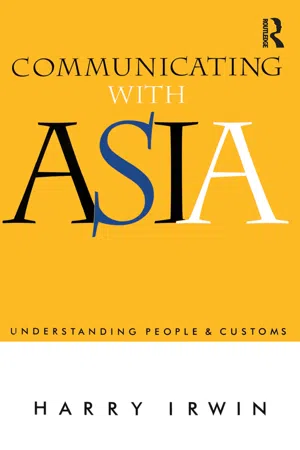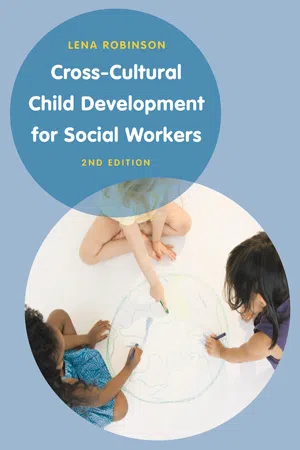Intercultural Communication
Intercultural communication refers to the exchange of information and ideas between people from different cultural backgrounds. It involves understanding and navigating differences in language, nonverbal communication, customs, and values to effectively interact and collaborate across cultures. Successful intercultural communication requires sensitivity, empathy, and the ability to adapt communication styles to bridge cultural gaps.
7 Key excerpts on "Intercultural Communication"
- eBook - ePub
- Farzad Sharifian, Farzad Sharifian(Authors)
- 2014(Publication Date)
- Routledge(Publisher)
...A search conducted on the same day in the Linguistics and Language Behavior Abstracts (LLBA) database (ProQuest) turned out 17,322 results for ‘Intercultural Communication’ and 14,559 for ‘cross-cultural communication’ – and these hits only include the relevant works published in English. Within the framework of this chapter, it is impossible to survey the myriad of books and articles individually. Instead, the attempt is made here to trace basic orientations, theoretical positions and philosophical models towards the triangular constellation of language, culture and (intercultural) communication that, implicitly or explicitly, underlie most works and approaches, and to highlight the particular contribution cultural linguistics can make and has already made to the field. In concurrence with the multitude of works on this subject matter, one finds nearly as many definitions of ‘Intercultural Communication’ or, for that matter, ‘cross-cultural communication’. Although, in my view, these two terms are interchangeable (see Allwood 1985 : 1; Gudykunst 2003 : vii; Scollon et al. 2012 : 8–10, for a differentiation), the more common and perhaps more encompassing term ‘Intercultural Communication’ is used in this chapter. Trying to define this term for the present purpose would lead into a kind of regress, because such a definition – in light of the title of this chapter – would require separate definitions of ‘language’, ‘culture’, and ‘communication’ as well (see Chapters 4 and 7 this volume). To avoid terminological and conceptual entanglements, it seems expedient to presuppose a certain understanding of these terms on the side of the reader and to adopt the near tautological definition of Intercultural Communication as ‘communication between people of different cultures’, proposed by Bennett (1998 : 2). The generality of this definition, however, does not imply a theoretical randomness, as should become clear in the course of this chapter...
- eBook - ePub
Communicating with Asia
Understanding people and customs
- Harry Irwin(Author)
- 2020(Publication Date)
- Routledge(Publisher)
...What is important is that communicating will lead to clarification and enhanced understanding. What, then, is Intercultural Communication? The same authors provide an extension of the above definition to define Intercultural Communication as a ‘symbolic, interpretive, transactional, contextual process in which people from different cultures create shared meanings’ (Lustig & Koester 1993, p. 51). This simple and straightforward definition places additional emphasis upon the importance of context to communicating by recognising that people involved in communicating may be from quite different cultural contexts. This book focuses upon one particular type of such Intercultural Communication. It is concerned about communicating across and beyond the social, political, historical and religious cultural boundaries that are associated with nations and with international communication; specifically it is concerned with communication involving Australians and people whose backgrounds and life experiences originate in the various nations of Asia. While this is the appropriate focus for approaching Intercultural Communication for the purposes of this book, it is recognised that the term ‘Intercultural Communication’ can equally well be applied to communication between people representing other types of cultural backgrounds. For example, different workplace cultures for managers and for shopfloor employees, and different socialisation cultures in childhood and adolescence for males and females lead to discussions and analyses of occupational Intercultural Communication and gender-based Intercultural Communication. Mention of these various forms of Intercultural Communication facilitates introduction of the idea of identity, and of the role of identity and identification in the process of communication. These are issues which will be discussed further, especially in Chapters 4 and 5...
- Jane Jackson(Author)
- 2019(Publication Date)
- Routledge(Publisher)
...Chapter 3 Language, communication, culture, and power in context The way people communicate is the way they live. It is their culture. Who talks with whom? How? And about what? These are questions of communication and culture. (Smith 1966: 1) The fact is, when two or more languages come together, two or more peoples have come together and the result is always about power and identity. (Morgan 2002: 12) To be mindful intercultural communicators, we need the knowledge of both verbal and nonverbal communication in order to communicate sensitively across cultural and ethnic boundaries. (Ting-Toomey & Dorjee 2019: 309) learning objectives By the end of this chapter, you should be able to: 1 Define communication 2 Describe the process of human communication 3 Identify nine properties of communication 4 Explain the relationship between language, communication, culture, power, and context 5 Identify and describe high-context and low-context verbal communication styles 6 Explain the communication accommodation theory (CAT) and the difference between ‘convergence’ and ‘divergence’ 7 Identify the elements in the audience design framework and explain its relationship to the CAT 8 Explain the merits and limitations of communication style typologies 9 Identify the traits and behaviors of an effective intercultural communicator Introduction As discussed in Chapter 2, the relationship between culture and communication is not straightforward, rather it is multifaceted, personal, and intertwined. Accordingly, E.T. Hall (1959: 186) famously states that ‘Culture is communication and communication is culture’...
- eBook - ePub
Psychology and Culture
Thinking, Feeling and Behaving in a Global Context
- Lisa Vaughn(Author)
- 2019(Publication Date)
- Routledge(Publisher)
...Chapter 9 _____________________________ Intercultural Communication and Education ■ Introduction ■ Communication and Verbal Language ■ Nonverbal Communication ■ Intercultural Communication in General ■ Culture and Education ■ Teaching and Learning across Cultures ■ Diverse Forms of Learning ■ Multicultural Education ■ Cultural Competence and Education ■ And So Forth (Indigenous Knowing) Introduction W ITH INCREASED TRAVEL, multinational corporations, and universities with study abroad and teacher/student exchange programmes, people are socializing more across cultures while also having the opportunity to engage in Intercultural Communication. Every intercultural encounter requires at least an attempt at communication, and communication provides the basis for most aspects of everyday life including education, work, and relationships. Communication also plays an important role in passing on cultural values from one generation to the next and in our understanding of culture and cultural influences on behaviour. Both verbal and nonverbal communication are essential elements in successfully transmitting and receiving messages within communicative interactions and practising cultural humility. Communicating with people from different ethnic, racial, religious, socioeconomic, language, and national backgrounds can be challenging and complex due to the myriad of factors involved and the assumptions about what is meant. Communication involves more than verbal language, although communication via verbal language is unique to human beings. Being proficient in verbal language is essential to effective communication. Communication consists of more than just verbal language but also involves having personal space and distance when talking, a degree of physical touching, discussing appropriate and inappropriate topics, use of media, and nonverbal communication (tone of voice, facial expressions, body movements, and eye contact)...
- eBook - ePub
- Michael Byram(Author)
- 2020(Publication Date)
- Multilingual Matters(Publisher)
...1 Defining and Describing Intercultural Communicative Competence Introduction The assessment of an individual’s ability to communicate and interact across cultural boundaries with people of other social groups is facilitated by a detailed description of the process involved and definition of what is expected of the individual. It is an advantage to the assessor but also to both teacher and learner. All three can benefit from clarity and transparency (Council of Europe, 1993: 5) and agree upon the aims and purposes of the teaching, learning and assessment processes in which they are involved. It is important to remember, too, that their aims and purposes are determined in part by the societal contexts in which they find themselves – national, international and intranational – and in part by the preoccupations of institutions, which in turn reflect those of the societies in which they function. In this first chapter I shall begin to describe and define intercultural communicative competence (ICC) as it relates to foreign language teaching (FLT). This will involve building up a view of ICC from a base in existing FLT theory, and adding to it insights from other disciplines, in order to offer a model of ICC capable of informing discussion of teaching and assessment by FLT professionals. I shall, however, also consider how that model relates to some specific contexts, to illustrate the general need always to define models of ICC according to the requirements of the situations in which learners find themselves. 1 Communicating Across Linguistic and Cultural Boundaries and Frontiers 2 Communicative competence For linguists and language teachers the term ‘competence’ is dominated by its use by Chomsky and Hymes, for both of whom competence is the idealised language ability of a speaker on the basis of which they perform language in a real world in real time, with all the constraints that this implies...
- eBook - ePub
- Gary P. Ferraro, Elizabeth K. Briody(Authors)
- 2017(Publication Date)
- Routledge(Publisher)
...Chapter 4 Communicating across cultures Language Chapter objectives: 1 Articulate several reasons for learning a new language. 2 Explain the Sapir–Whorf hypothesis. 3 Discuss the virtues of an indirect style of communication as well as the misinterpretations that may accompany it. 4 Respond in the affirmative to the statement: Everybody has an accent. Business organizations, like other social systems, require effective communication to operate efficiently and meet their objectives. International business organizations require effective communication at a number of levels. The firm must communicate with its work-force, customers, suppliers, and host-government officials. Effective communication among people from the same culture is often difficult. But when attempting to communicate with people who do not speak English—and who have different ideas, attitudes, assumptions, perceptions, and ways of doing things—one’s chances for miscommunication increase enormously. The ideal of linguistic proficiency in global business Defining language A language is a symbolic code of communication consisting of a set of sounds (phonemes) with understood meanings and a set of rules (grammar) for constructing messages. Language is a universal in all cultures of the world. The meanings attached to any word by a language are totally arbitrary. For example, the word cat has no connection whatsoever to that animal the English language refers to as cat. The word cat does not look like a cat, sound like a cat, or have any particular physical connection to a cat. Somewhere during the development of the English language, someone decided that the word cat would refer to that particular type of four-legged animal, whereas other languages symbolized the exact same animal by using totally different words...
- eBook - ePub
Cross-Cultural Child Development for Social Workers
An Introduction
- Lena Robinson(Author)
- 2020(Publication Date)
- Bloomsbury Academic(Publisher)
...In particular, it focuses on bilingualism and the relationship between language and ethnic identity. This chapter will examine some of the culture-bound values of black people and their relationship to interethnic communication. It will explore the significance of nonverbal behaviours among black children and young people and social workers. The meanings we interpret from nonverbal behaviours are culturally conditioned. The differences in nonverbal behaviour among cultures can cause breakdowns in Intercultural Communication (Barna, 1994; Barna & Barna, 2012). The importance of nonverbal communication in interethnic settings is significant because the lack of trust between ethnic communities has caused interethnic communicators to reject the values of verbal communication and to search for nonverbal cues as indicators of real meanings and response in interethnic communication situations. Finally, implications for social work with black children, adolescents, and their families are discussed. Bilingualism and Intercultural Communication Bilingualism is a far more common phenomenon than many monolingual native speakers imagine. Over 70 per cent of the world’s population speaks more than one language (Siraj-Blatchford, 1994). Thus, it is as natural (if not more) to grow up speaking more than one language as it is to grow up speaking only one language. Studies have shown the following: bilingual individuals can selectively attend to stimuli better than monolinguals and can suppress interference from competing stimuli in attention (Engel de Abreu et al., 2012; Gollan et al., 2014), thinking in a second language reduces biases when making decisions (Keysar et al., 2012) and that early exposure to a multilingual environment promotes effective communication (Fan et al., 2015)...






